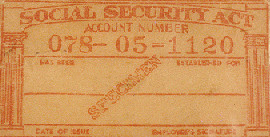 Social Security Facts
Social Security Facts
Frequently asked questions and interesting information about Social Security and Social Security Numbers.
What is Social Security?
Social Security is a Retirement and social safety net program providing economic security for millions of Americans, including: retirees, disabled persons, and families of retired, disabled or deceased workers. Over 158 million Americans contribute to Social Security taxes and 57 million collect monthly benefits in 2013. One in four household receive Social Security Benefits in some form.
Social Security was established by the Social Security Act of 1935. Social Security is what is known as a pay-as-you-go program meaning that workers today pay Social Security taxes and that money is paid out as monthly income to beneficiaries. As the current workers retire and begin to collect Social Security benefits the next generation of workers will pay into the system. A pay-as-you-go system differs from a which are "pre-funded" retirement program where the money is accumulated in advance so that it will be available to be paid out to today's workers when they retire. A pre-funded program protects employees in case there is not a steady stream to new workers.

How many Social Security Numbers are There?
SSNs are 9 digits. There are certain groups of Social Security Numbers that will never be issued, such as: numbers that start 000,333 or have first three digits greater than 771. Also none of the 3 groups of numbers - the Area, Group, or Series number - can be all zeros. Plus several smaller groups of numbers that will never be issued.
This leaves us with a proximately 760 million Social Security Numbers to issue. Since 1936 when SSN were first issued we have used nearly 350 million numbers so far leaving us with 410 million remain numbers to issue. The SSA issues approximately 4 million numbers per year. This means that we can continue using the same 9 digit social security number without ever reusing a number for at least the next 100 years.
Social Security Numbers Reserved for Advertising
In 1938, shortly after Social Security Cards were first issued, the E. H. Ferree Company promoted their new wallet by showing that a Social Security Card fit. The company displayed a sample card in each wallet. The Social Security Number printed on the sample car is 078-05-1120—the Social Security Number of the company's vice president's secretary.
Despite the sample card being red and having the words 'specimen' printed on the card, many Americans mistook the card for their own. Since 1938, over 40,000 people have claimed the number printed on this advertisement as their own. The number was still found to be used to several individuals as late as 1977.
As a result of this advertising mishap, the Social Security Administration has set aside a small set of Social Security Number to be used exclusively in advertisement. These reserved numbers range from 987-65-4320 to 987-65-4329.
Additionally, for privacy reasons the Social Security Administration advises you not to carry your Social Security Card in your wallet on a daily bases.
Enumeration at Birth
When Social Security Numbers were first issued they were used solely for tracking each worker's covered earnings over their career. People do not start working until their early to mid-teens so they did not need a Social Security Number until then. This is why many people's place and date of birth does not match the issuing location and date of their social security number.
Shortly after the issuance of Social Security Numbers, the federal government realized the usefulness of unique identification numbers for all Americans and began using the number to track other information such as all federal taxes and military service. Still Social Security Numbers were not needed at birth.
It was not until the late 1980's when the IRS began requiring that dependents aged 2 or older claimed on Federal income tax forms must have a Social Security Number. After this change, parents and hospitals quickly adopted Enumeration at Birth policies. Enumeration at birth is still optional.
After 1988, nearly all issuances information found in the Social Security Verification Tool are the same as place and date of birth.
Enumeration at Entry
Enumerate at Entry (EAE) refers to the issuance of Social Security Numbers to immigrants who are Lawfully Admitted Permitted Residents. The Department of State is in charge of issuing Social Security Numbers to these lawful immigrants.
Individuals who receive Social Security Numbers through the Enumeration at Entry program can only receive Social Security Income under certain conditions such as that they came to this country as refugee seeking asylum or they later become a naturalized citizen.
A block of Social Security Numbers was reserved for EAE when numbers were first issued just as each state was issued a block of numbers to distribute. EAE numbers were also subject to Social Security Numbers randomization.
First Social Security Number Issued

The first Social Security Numbers were issued by the post office. Cards were issued to Post Offices throughout the country who then issued the cards to individuals. The first cards were distributed in late 1936.
In mid-November, 1936 the first Social Security Card was issued to John David Sweeney, Jr. in Baltimore, Maryland at the age of 23. Mr. Sweeney died in 1974 before receiving any benefits. However, his widow was able to receive survivor benefits until 1982. His Social Security Number was 055-09-0001.
Baltimore, Maryland is close to the Social Security Administration building in Washington, D.C. Because of this close geographical proximity Baltimore was able to issue the first card. The first card issued is not the lowest number issued (001-01-0001) because groups of numbers were assigned state by state starting in the northeastern states and moving south and then west.
The lowest Social Security Number issued was to Grace D. Owen of Concord, New Hampshire. She applied for her number on November 24, 1936 and was issued the first card typed in Concord, which, because of the area number scheme, also happened to be the card with the lowest possible number.
Why are Social Security Cards printed on poor quality paper?
You may wonder why in today's world with all our technology and durable plastic cards everywhere, why are Social Security Numbers still printed on cheap, fragile paper. Today nearly every grocery store in America gives out free plastic rewards cards to every customer. But Social Security cards are still printed on paper that is barely above paper towel quality?
The answer is surprisingly sensible and has nothing to do with saving money. The delicate paper is used so that if a Social Security Card is lost it will quickly fall apart before someone happens upon the card.
For this same reason the Social Security Administration advises you do not carry your Social Security Card with you in your purse or wallet on a regular basis.
Whats Next?
If you lost your Social Security Card you can apply for a new ssn. You may also be interested in our Social Security Number Lookup Tool or learn more about your Social Security Benefits.